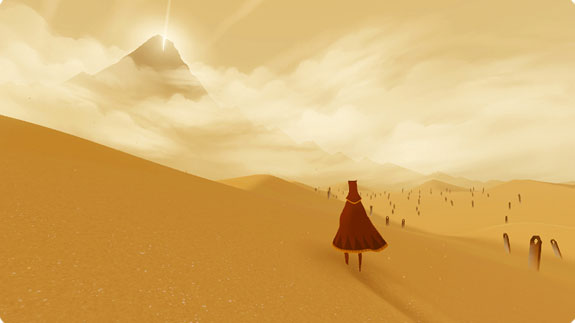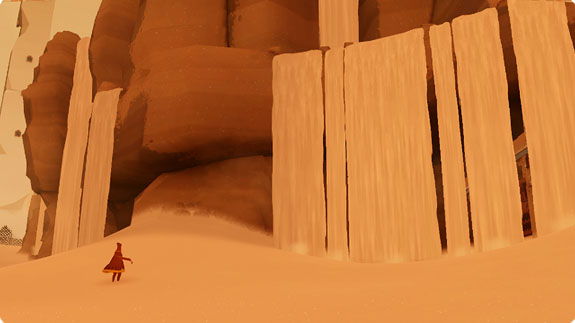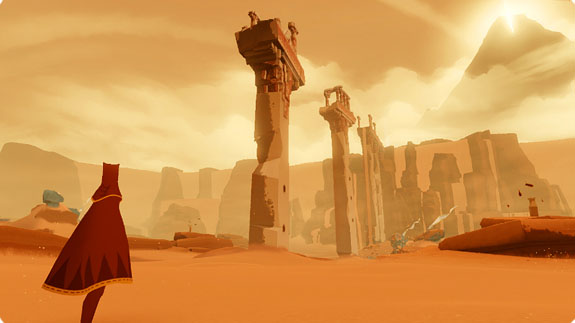
Journey is one of the most difficult games to describe to someone who has never seen it with his or her own eyes. Perhaps the simplest description would be that it is an exploration of game space that does not rely on player empowerment, but rather makes players feel small and inconsequential in a vast, inhospitable environment. It also provides the opportunity for strangers to take the journey together, rethinking what multiplayer gaming can mean. Coming from Jenova Chen and That Game Company, these descriptions should come as no surprise; the 9-man studio’s previous titles, flOw and Flower, were indeed nonstandard experiences, and Journey, while more closely resembling familiar game design, is shaping up to be equally unique.
Journey takes place in a large desert world, where the only elements appear to be sand, sun, wind, and… cloth. There is as of yet no explanation of how or why the game’s anonymous protagonist came to this land; Mr. Chen skipped the exposition in his E3 presentation and gave no formal synopsis of the game’s plot or even stated conclusively that whatever minimalist narrative is in place by the time it ships will be any less mysterious in that regard.
The primary objective in Journey is ostensibly to reach a huge mountain with a pillar of light at its peak. This immense crag dominates the skyline, always in view high above the horizon and framed by a mass of clouds against an empty sky. It is deliberately presented in a way that conveys a sense of incredible distance from the player, but also a clear desire to reach its peak after navigating the desert below.

Journey will be thatgamecompany’s most complex game to date, featuring full 3D controls with movement mapped to the analog stick and camera control to the SIXAXIS motion sensors. It will also be a two-button game, straying from the company’s previous one-button-only philosophy. This time around, one button will make the protagonist jump (and sometimes fly), and the other button will make her sing, an action Chen calls harmonizing. Harmonizing is how players will interact with certain objects in the environment, as well as communicate with other players if and when they meet.
Sand and cloth. Once again, wind animates thatgamecompany’s game world, and is visible both in the sand that covers the ground and in the many pieces of red cloth that populate the otherwise barren desert. These textiles range from collectible, loose-leaf-sized rags, which attach to the protagonist’s berqa in an ever-extending streamer and can be consumed in order to fly short distances, to large sheets that must be harmonized with in order to proceed. One part of the presentation showed the protagonist harmonizing with three freely waving tapestries in close proximity to one another, after which a cloth bridge was formed, linking the current area to the next space.
Progress doesn’t appear to be forced, however. It looks like Chen and company would like players to slowly explore the game world and simply enjoy being there. When asked about what there is "to do" between harmonizations and transitions, Mr. Chen noted the virtually tactile properties of the sand, and that the protagonist could "surf" down dunes and across flatter areas where the sand takes on a more water-like role, producing waves that continue along the surface until colliding with a rock or other structure. He demonstrated the way the sand moves under the character’s feet and leaves a trail, and how one can fly and glide from place to place. There will also be some hidden secrets to discover, such as tapestries displaying pictorial histories of the game world. As the name implies, this game experience seems to be very much about the journey.

This journey can also be shared with someone else, if a player so desires. Using the analogy of hiking, Chen explained the game’s multiplayer, which looks to be based on a persistently online setup. Just as a person goes hiking alone, possibly meeting others along the way and possibly joining one another in their trip, Journey will occasionally link two players and let them decide whether to accompany one another or not. These encounters will be random, anonymous, and traffic-controlled, ensuring that a player will only meet one other player at a time, and will never completely lose the sense of isolation and smallness. According to Chen, the game CAN be played "all the way through" by oneself, but he also mentioned that "it may be easier and safer to hike together," reinforcing the focus of meeting and cooperating with other players, but not downplaying player choice in the matter.
There will be very few other characters in the game, but Chen did give a brief look at a statuesque, white NPC that will help players with nonverbal hints and mysterious markings whose meanings he declared are still up in the air. As for opposition, "enemies are the obstacles posed by nature."
Despite the lack of much concrete information about Journey, this is certainly one to watch as 2010 turns to 2011. Jenova Chen says that we should be playing Journey on the PlayStation 3 "hopefully next year."

















